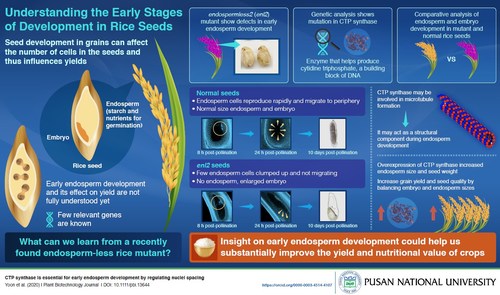BUSAN, South Korea, Aug. 24, 2021 /PRNewswire/ — The endosperm is the nutritional part of harvest cereals like rice; controlling the accumulation of starch during the final stages of endosperm development through genetic modification can improve crop nutrition and value. Scientists from Pusan National University, Korea, analyzed the genome of a rice plant mutant whose seeds contained no endosperm and an abnormally enlarged embryo. Their findings shed light on early rice embryo development and can lead to better rice crop yield and nutrition.
Agriculture, particularly that involving grains, has always been a steadfast pillar of civilization. Our current understanding of plant biology and genetics has helped us greatly improve the quality and yield of crops through various techniques, some of them focusing on the complex processes involved in seed development.
The seeds of most flowering plants have two distinct structures: the embryo and the endosperm. The embryo cells are created during fertilization, whereas the endosperm constitutes a structural and nutrient-rich body that protects and supports the embryo. The endosperm accounts for most of the nutritional value of the harvest in cereals like rice; many genetic studies focus on how to control the accumulation of starch during the final stages of endosperm development. On the other hand, not much is known about the genes that orchestrate early endosperm development in rice.
A team of scientists led by Assistant Professor Lae-Hyeon Cho (ORCID ID: 0000-0003-4514-4107) of Pusan National University, Korea, recently conducted a study to fill part of this knowledge gap. In their work, which was published in Plant Biotechnology Journal, the team analyzed the genome of a rice plant mutant whose seeds contained no endosperm and an abnormally enlarged embryo.
They identified a single mutation in the gene that codes for cytidine triphosphate synthase (CTPS), an enzyme that helps produce some of the building blocks of DNA and RNA. They also clarified the relationship between CTPS and the endosperm. It turns out CTPS forms macromolecular structures during the early stages of endosperm development, helping endosperm cells migrate within the seed. The mutant, having an altered form of CTPS, failed to produce this supporting structure, and thus its seeds ended up being endosperm-less.
Most notably, the scientists also showed that overexpression of CTPS in genetically modified rice plants results in a larger endosperm. This opens up an avenue for fine-tuning the size ratio between endosperm and embryo. "Controlling the embryo and endosperm size determines the quantity and quality of the seeds," explains Dr. Cho, "It is important to increase the size of the embryo in moderation while also increasing that of the endosperm."
Overall, the newfound insight provided by the research team could lead to more fruitful rice plantations. "Early seed development in rice ultimately determines the number of cells in the seed and is closely related to yield," highlights Dr. Cho, "Our study may pioneer the field of research on the early development of the endosperm and contribute to improving the quality of food crops in the future." Let us hope further progress in this field helps make food more accessible to the whole world!
Reference
Title of original paper: CTP synthase is essential for early endosperm development by regulating nuclei spacing
Journal: Plant Biotechnology Journal
DOI: https://doi.org/10.1111/pbi.13644
About Pusan National University
Website: https://www.pusan.ac.kr/eng/Main.do
Contact:
Lae-Hyeon Cho
+82 51 350-5508
317249@email4pr.com
SOURCE Pusan National University


